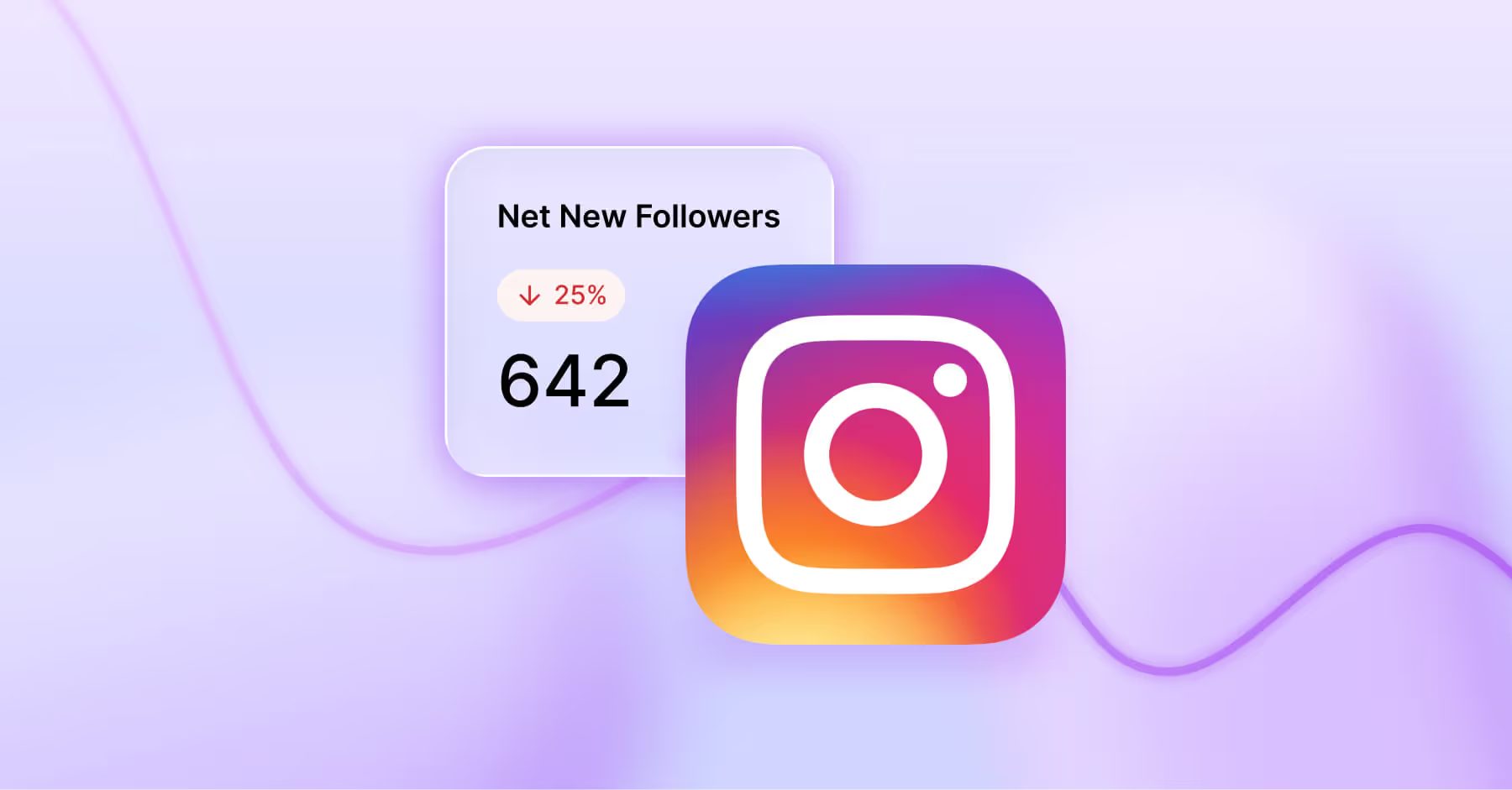How Does the Instagram Algorithm Work in 2026?
Learn how Instagram's 2026 algorithm ranks content and how brands and creators can boost visibility.

It is common for social media marketers to find themselves needing clarification on why suddenly their Instagram posts aren't generating high engagement. Even after spending hours researching the latest relevant trend or curating a post similar to those that have led to high engagement previously. As a result, marketers must keep up with the ever-shifting Instagram algorithms to maximize their content, regardless of how challenging it can seem. However, once understood and applied, it can help marketers optimize the effectiveness of their content.
Throughout the following guide, we will answer all your questions regarding how to figure out your Instagram algorithm and set yourself up for success when planning your Instagram strategy.
TL;DR
- Instagram uses multiple AI systems to personalize content across Feed, Reels, Stories and Explore.
- Posts are ranked by relevance, not recency. Engagement history, post quality and user behavior are more important than ever.
- In 2026, Instagram content can appear in Google search, making SEO (captions, keywords, alt text) essential.
- Saves and shares carry more weight than likes or comments, especially for Reels and Feed posts.
- To boost reach, post consistently, follow visual trends and share content when your audience is most active.
What Is the Instagram Algorithm?
Contrary to popular belief, there isn’t one singular algorithm that dictates what Instagram users see. Rather, Instagram uses multiple algorithms along with categories and processes that each help personalize and determine what to boost to individual feeds.
The Instagram algorithm is a formula made up of AI-powered signals that determine what appears on your Instagram feed — this applies to Stories, Reels, feed posts and anything that appears on the Explore page.
To personalize each user’s experience, the Instagram algorithm ranks content based on key engagement signals. These signals include:
- How popular the post is: The frequency and how many people like, comment, share and save a post. Per Instagram, these signals are more relevant for popularity on the Explore page than in the Feed or Stories.
- Interaction history: Whether or not you’ve interacted with the poster’s content. This doesn’t necessarily mean you follow them, but if you’ve interacted with them in the past, the algorithm is slightly more likely to recommend their content.
- User activity: Which posts an Instagram creator has liked, saved or commented on and how they interact with other content on their Explore page.
- User information: How many times other users have interacted with the poster recently (up to the past few weeks). If many people engage with their content, it’s more likely to appear for others.
Ultimately, the algorithm combines information about your content with individual user behavior, content type and platform trends to provide the right content to the people who are most likely to engage with it.
How Does The Instagram Algorithm Work in 2026?
Instagram’s algorithm in 2026 is powered by multiple AI systems that constantly learn and adapt. These systems use a variety of input signals, like the content of a post, how users have interacted with similar posts and individual engagement history to predict what each person is most likely to find relevant or valuable. As users scroll, the algorithm makes real-time decisions, responsively adjusting rankings based on how content performs and how the system itself evolves over time.
Ranking is also influenced by broader patterns of engagement. If a post receives consistent positive interactions (such as saves, shares or long watch times), it’s more likely to appear higher in feeds. On the flip side, if content is flagged, performs poorly or violates community guidelines, it’s either demoted or removed. Multiple AI systems work in tandem, with some focused on content from accounts users follow and others that surface recommended posts. This helps to create a feed that blends personalized, high-interest content with platform-wide recommendations.
One of the most significant changes in 2026 is Instagram’s new partnership with Google, rolled out in July. Now, public content from creators and business accounts (personal accounts are not included in this update) can be indexed, and therefore appear in Google search results (SERPs), which expands organic reach far beyond the app. This update means that posts optimized with relevant captions, alt text and keywords can gain visibility through both Instagram’s algorithm and Google’s search engine, bringing your social content (and your brand) to users who might not be active on Instagram.
For brands, this shift reinforces the importance of strategic content planning: visuals need to engage in the feed, but also be discoverable through search. That means thinking beyond Instagram’s ecosystem and integrating social media SEO best practices into your Instagram strategy, like targeted keywords, consistent branding and valuable, searchable content. Most searches are categorized as either transactional (providing a product or service), informational (what question does your content help answer?) and navigational (what website or brand is a user looking for?). For the purpose of Instagram, most content will fall under transactional or informational — understanding your content’s purpose in a user’s search journey will help you create intentional content.
In light of understanding how the algorithm works and the factors taken into account when ranking content, let's examine how it works explicitly for different content formats on Instagram.
Instagram Algorithm for Feed Posts
The algorithm for feed posts has changed to focus mainly on user interests over when it was posted. With AI now helping to drive personalized ranking, Instagram evaluates content and relevance and how it aligns with a user’s recent in-app behavior. When it comes to determining how the algorithm ranks your feed content, consider the following ranking signals:
- Post details like format (photo or video), how long the video is, how well it matches trending topics and how many likes or interactions it has.
- User-creator relationship, meaning how often a user engages with that account’s content, including DMs, comments, shares and profile visits.
- User behavior like the types of content a person has interacted with recently and the keywords or topics they’ve searched for.
- SEO signals, including caption keywords and alt text, now factor into visibility — especially for posts that may appear in Google search results.
To rank higher in the feed:
- Use keyword-rich captions and alt text to boost discoverability both on Instagram and in Google SERPs.
- Create trend-aware content, especially around current formats and conversations.
- Post consistently with a content cadence your audience expects.
- Prioritize interaction by encouraging saves, shares and comments — especially with accounts your audience is likely to follow, too.
- Track which content types perform best, then double down on those.
Why it matters: Feed posts are still a major touchpoint, but relevance now beats recency. If your posts regularly align with a user’s behavior and interests, they’re far more likely to be prioritized in their feed. That means the right content can keep performing long after it's published.
Instagram Algorithm for Reels
With Instagram Reels, users don't just see content from the people they follow but from a much broader pool of creators. AI-powered recommendations now drive Reels more than any other format, surfacing content that considers which content users find most entertaining and providing them with more of that.
The algorithm focuses on three signals:
- User activity, like which Reels they’ve liked, commented on, shared, saved or watched all the way through.
- Interaction history, meaning whether a user has engaged with a creator’s content before — even if they don’t follow them.
- Creator and content signals, such as use of trending audio, overall engagement with the creator’s other Reels and whether their content has gone viral.
- Content quality and clarity, like visual resolution (are you using the best social media image size?) and audio quality (is your sound synched accordingly?) will impact if Reels content surfaces.
To increase Reels performance:
- Use popular or trending audio that fits your brand.
- Create short-form content that captures attention within the first few seconds.
- Encourage engagement by prompting comments or reactions.
- Stick to a consistent posting schedule and test what resonates.
- Add concise, keyword-rich captions to support visibility in Instagram and Google search
Why it matters: Using Instagram Reels to grow your business offers unmatched reach on Instagram. If you align your content with entertainment trends and keep your strategy tight, your Reels can reach entirely new audiences without relying on ads or existing followers.
Instagram Algorithm for Stories
Instagram Stories have a 24-hour lifespan, so timeliness is less important. Consistency and regular sharing are, therefore, more critical — brands should also look for opportunities in their Story strategy to encourage interaction by including elements like questions, quizzes and polls. Stories now benefit from AI that prioritizes personal interaction history, showing your content to users you’ve built relationships with.
More than anything else, marketers need to keep their eyes on their Instagram Story insights to determine what works and what should change to stay ahead of the competition.
- Instagram prioritizes Stories from accounts users frequently engage with (likes, comments, shares, saves).
- Story content appears in chronological order, but engagement history plays a role in who sees what first.
- Stories expire after 24 hours, so recency matters less than consistency.
- Focus on:
- Posting regularly
- Using interactive tools like polls, quizzes and question stickers
- Prompting direct replies or emoji reactions, which signal stronger engagement.
- Engagement through interaction signals tells the algorithm your content is worth surfacing.
Why it matters: Stories are built for habitual viewing. The more often you show up and encourage responses, the more likely your content is to stay at the front of the line. The algorithm rewards relationship-building, so leverage Story features that spark meaningful interactions. Track your Story insights to refine your approach and ensure you're not missing easy wins.
Instagram Algorithm for the Explore Page
Similar to how the Instagram algorithm works for feed posts, the Explore page values content that seems interesting and relevant to users. But there is a twist. The content on the Explore Page is almost entirely made up of content from accounts that the users do not follow — thus presenting a fantastic opportunity for brands to capture the attention of new audiences. And as of recently, viewers can use the search bar to enter keywords and find specific content.
- The algorithm selects content that aligns with users’ interests and browsing habits.
- Content shown is almost always from accounts users haven’t followed yet.
- Users can now search by keyword, increasing the importance of captions and metadata.
- Posts with high engagement and strong topical relevance are surfaced faster, especially if they include SEO-friendly captions and alt text.
- To increase visibility on Explore:
- Post consistently with a clear aesthetic and voice.
- Write engaging, relevant captions.
- Use hashtags your target audience actually follows or searches.
- Think from your audience’s perspective — what would they search or click?
Why it matters: The Explore Page is your shot at organic reach beyond your followers. Posting strategically here means your content works harder, reaching users who are already interested in what you offer — even if they’ve never heard of your brand.
Instagram Algorithm Tips
Curious how to take your overall Instagram presence to the next level? While Instagram and its algorithm have evolved since its 2010 inception, ultimately, it aims to deliver personalized, relevant and engaging content to each user. With a shift from chronological feeds, brands need to rethink their approach to engagement.
Here are five tips for boosting your content in Instagram’s algorithm.
1. Prioritize Original, Value-Driven Content
Instagram’s latest updates favor original content more than ever. Repurposed or overly promotional posts are getting deprioritized, while helpful, entertaining or educational content gets boosted. Brands should focus on creating posts that solve a problem, teach something new or entertain in a unique way.
2. Leverage Visual Trends
While original, value-driven content continues to be important for Instagram visibility, this doesn’t mean brands should neglect the impact of Instagram trends. In fact, the Instagram algorithm tends to push content that incorporates trending audio or is already experiencing significant engagement — and tapping into these Instagram trends helps your content achieve higher engagement.
3. Optimize Captions for Engagement and Search
In 2026, Instagram’s search functionality uses natural language processing to surface posts based on caption relevance, not just hashtags. Brands should write captions that include relevant keywords users might search for (e.g., “sustainable skincare tips”), while still encouraging engagement through questions, CTAs or short storytelling. Emojis and line breaks can help improve readability without sacrificing SEO.
4. Encourage Saves and Shares
While likes are, and will always be, a fundamental signal that your content is doing well, it’s not necessarily the most important metric to track. In fact, Instagram’s algorithm puts more weight on saves and shares over likes and comments. Encouraging saves and shares, whether it’s because your content is entertaining, educational or offers value in some other way, is a great way to create content that users will want to reference later.
5. Post When Your Audience Is Most Active
While the best time to post on Instagram depends on your industry, timezone and other factors, it’s important to identify when your audience is most active and try to share content when they are. Tools like Dash Social’s Scheduler can help you pinpoint the best time to post when your audience is online, engaged and ready to save and share.
Instagram Algorithm FAQs
How have hashtags changed discoverability on Instagram in 2026?
Hashtags still help with discoverability, but they’re no longer the primary way content gets found. Instagram now relies more on keyword-based search and interest signals. That means the platform can surface posts that match a user’s behavior, even if the content doesn’t include the exact hashtag they searched for. That said, hashtags still play a supporting role:
- Niche and branded hashtags help categorize content
- They can increase visibility in Search and Explore results
- They’re still useful for campaigns and community-building
How do I fix my Instagram Algorithm?
If your content isn’t getting the reach or engagement it used to, the algorithm may no longer be recognizing your posts as relevant. The good news? You can retrain it. Here's how:
- Audit your content: Is it aligned with your audience’s current interests? Are you using formats they respond to (like Reels or carousels)?
- Post consistently: Irregular posting can disrupt engagement signals. Try sticking to a steady cadence.
- Encourage engagement: Prompt followers to comment, share or use interactive features like polls and questions.
- Engage with your own feed: The algorithm also tracks how you use the platform. Spend time engaging with the content and creators that reflect your brand’s interests.
- Use insights: Lean into the content that performs well and stop posting what doesn’t move the needle.
Fixing the algorithm isn’t instant, but with the right strategy, it can bounce back quickly — especially if you keep your audience at the center of your content decisions.
What are peak Instagram posting hours?
Instagram posting hours can vary depending on timezone, day and even depending on which industry you’re in. Generally, the global best time to post on Instagram is anytime after 10 p.m. right up until 12 a.m. local time — however, tools like Dash Social’s Scheduler can help you determine your unique best time to post so you can maximize your chances to earn the most engagement possible.





